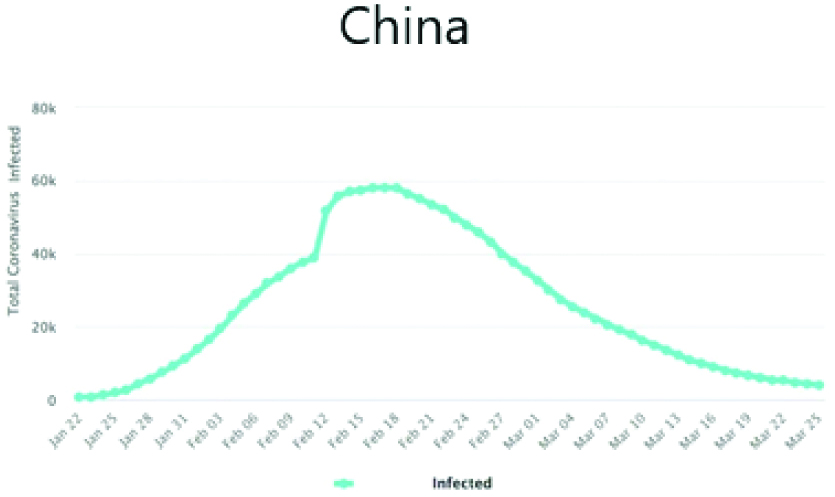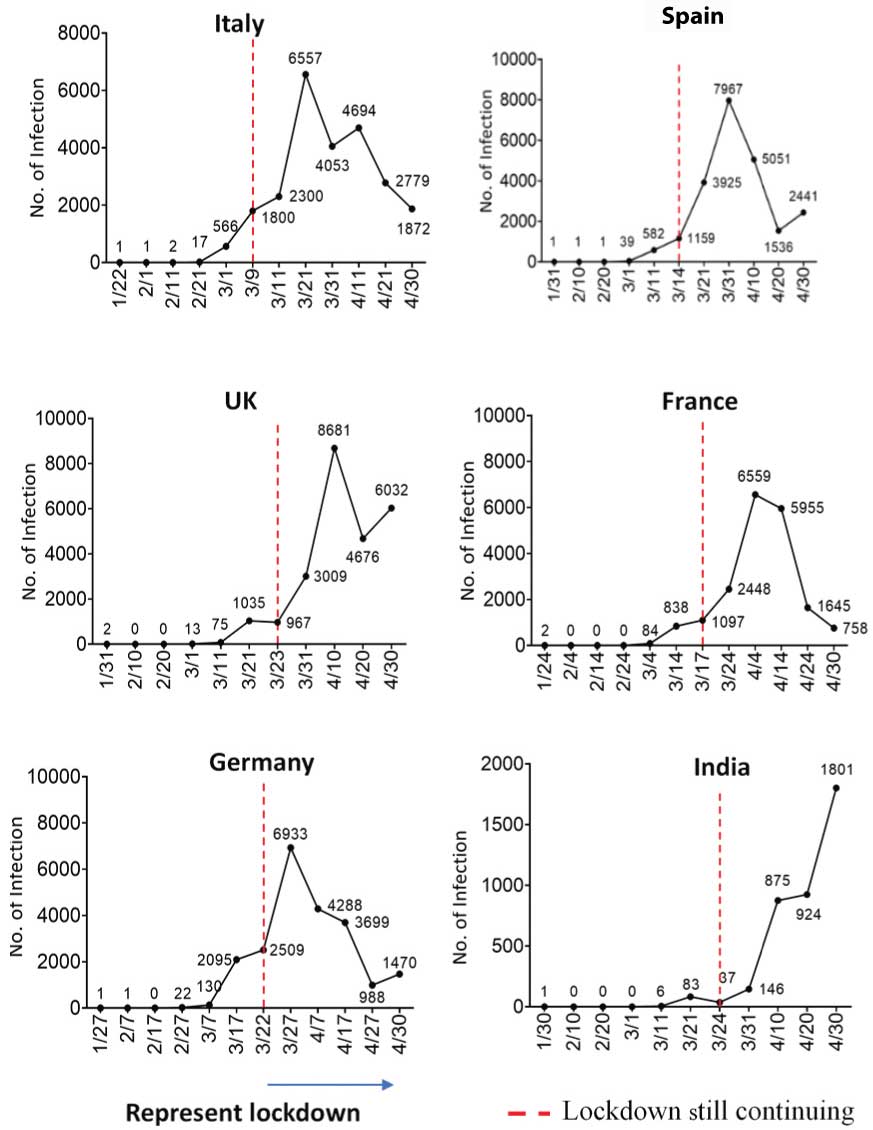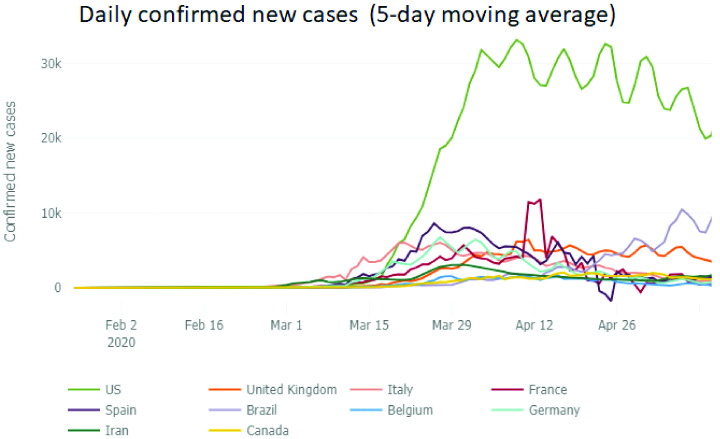Introduction
The novel COVID-19 caused by the infection of SARS-CoV-2 was declared a pandemic by the World Health Organisation (WHO) on March 11, 2020 [1]. COVID-19 emerged in Wuhan, China in December 2019 [2]. The authorities in Wuhan took an unprecedented step and locked down the city on January 23, 2020, to reduce the risk of further virus transmission [3]. Later, the same measures were taken elsewhere in China. Within a few weeks, cases of COVID-19 were detected in several other countries, and it soon became a global threat [4]. As of April 30, 2020, the virus had spread to more than 200 countries and infected more than 3,000,000 patients, resulting in more than 230,000 deaths [5]. Countries severely affected by COVID-19 include China, France, Russia, Iran, Italy, Spain, United Kingdom, and the United States [6]. On March 13, 2020, Europe became the new epicenter of the pandemic [7]. China took aggressive actions for public lockdown and strict guidelines for social distancing and hand sanitisation efforts that successfully reduced the number of new cases. Unfortunately, similar reductions were not mirrored in other parts of the world, including Iran, Italy, the US, and other European countries due to comparatively late implementations of lockdown and social distancing measures [8].
Authorities in many of those countries mentioned above realised that the only option to prevent the spreading of virus is lockdown and social distancing. Many countries all over the world declared lockdown, including internal and external travel. Public health experts and government officials are urging several measures, including social distancing, self-isolation or quarantine, strengthening health facilities to control the disease, and requesting people to stay in their homes [9]. Several countries announcing the closure of movie theatres, swimming pools, and other places where large groups gather, including educational institutions, to fight this invisible enemy. As of April 30, 2020, more than 150 countries have closed schools and educational institutions [10].
In the absence of any vaccine and antiviral drugs, this remarkable achievement was only possible because of the rigorous implementation of traditional public health measures to prevent the person-to-person spread of COVID-19 by separating people to interrupt the routes of transmission. The tools we have at present are hand sanitisation, isolation or quarantine, social distancing, and community containment. Only a few studies in the literature exist regarding lockdown and social distancing to reduce the spread of this infectious disease by breaking important routes of transmission [11,12]. This review will highlight the significance of lockdown and social distancing in preventing the spread of COVID-19.
Review
A recent study from Wuhan, China, reported on the development of confirmed domestic and international COVID-19 cases before and after lockdown measures. According to this study, Hubei province was placed under lockdown approximately three weeks after the start of the COVID-19 outbreak. In Wuhan, the restricted lockdown resulted in travel restriction to and from Wuhan to ensure rigorous adherence to home quarantine. The authorities also implemented social distancing by canceling events and gatherings, closing public places, and schools and universities. Because of the lockdown measure, the area saw a significant decrease in the number of COVID-19 cases, highlighting the benefits of lockdown on slowing the spread of COVID-19 [Table/Fig-1] [13]. China observed reappearance of cases when they started to lift the lockdown and this made them to implement the lockdown again [14].
Number of infected cases in China.

Lockdown is implemented in all European countries affected by COVID-19. In Europe, Italy and Spain comprise the European epicenter of SARS-CoV-2 infection with more than 120,000 COVID-19 cases and more than 10,000 deaths [5]. The first two cases of COVID-19 were detected on January 31, 2020, in Rome [15]. On February 21, 2020, 16 confirmed cases were discovered in Lombardy, Italy, with an additional 60 cases on February 22; the first death was also reported in Italy on the same day [16]. On March 8, the Italian government implemented forced quarantine for the region of Lombardy and other Italian provinces [16]. On March 9, the entire country of Italy was in lockdown and effectively quarantining more than 60 million people [Table/Fig-2] [16,17].
Number of cases per day in Italy, Spain, UK, France, Germany and India.

On January 31, Spain reported the first case of COVID-19 in the Canary Island of La Gomera [17]. On March 14, 2020, the Spanish government tightened its national lockdown, ordering all nonessential workers to stay at home for two weeks [18,19]. Just before the lockdown there were 4231 confirmed cases and it reached 2,13 435 as of 30th April [Table/Fig-2] [17]. As a result of the lockdown and social distancing, the number of COVID-19 cases per day began to decline, showing the beneficial effect otherwise it would have been reached double the number of April 30th [5].
On January 31, 2020, England confirmed their first two cases of COVID-19, and later, several cases were detected across the UK [20]. On March 25, the UK government restricted public gatherings and ordered businesses to close. As of April 30, 2020, there were more than 170,000 confirmed cases and 26,000 deaths in the UK related to COVID-19 [17,20]. After implementing lockdown and following social distancing, the data analysed from the COVID-19 symptom tracker app suggests that staying at home is impacting the spread of SARS-CoV-2 in the UK [21].
In France, the first cases of COVID-19 were reported on January 24, 2020, in Bordeaux [22]. The number of cases increased rapidly every day in France [23]. Because of this, on March 12, the French government closed all schools and universities, and banned gatherings of more than 100 people the following day, not including public transportation [23]. One day after banning gatherings of 100 people or more, all nonessential places, including restaurants, cafes, and cinemas, were closed [23]. As of this writing, France has more than 160,000 confirmed cases and 24,000 deaths due to COVID-19 [Table/Fig-2] [5,17]. Immediate effect of lockdown implementation was not seen however, it helped in reducing number of cases per day as of April 30th [Table/Fig-2,3] [17,24].
Daily confirmed new cases in various countries (5-day moving average).

Germany has also been severely affected by COVID-19 and reported its first cases on January 27, 2020 [23]. On March 15, 2020, Germany closed its border with two neighboring countries, and on March 22, the government announced a national curfew [23]. New coronavirus infections started are accelerating again in Germany just days after its leaders loosened social restrictions, raising concerns that the pandemic could once again slip out of control. As of April 30, 2020, Germany has reported more than 160,000 confirmed cases and 6,000 deaths due to COVID-19 [15]. The number of active cases before announcing the national curfew was 22,000 and it remained at 32,000 on 30th April. The recovery of more than 150,00 patients were seen on 30th April 2020 [Table/Fig-2,3] [17,24].
The US became the new global epicenter of COVID-19 with more than 1,000,000 confirmed cases and more than 60,000 deaths as of April 30, 2020 [5]. The first US case of COVID-19 was confirmed on January 20, 2020. On March 16, the US government advised against gatherings of more than 10 people, and on March 19, US citizens were advised against international travel [Table/Fig-3] [24,25]. In response to the COVID-19 pandemic, Trinidad and Tobago raised its Disease Outbreak Response System Condition alert to “orange,” the second highest level. As of April 30, 116 confirmed cases and 8 deaths due to COVID-19 were reported from Trinidad [26]. The lockdown implementation and social distancing in this country helped in preventing the community spreading and flattening COVID-19 curve.
On January 30, 2020, India confirmed its first case, with two additional cases confirmed in early February. On March 12, India reported its first death due to COVID-19. As of April 30, 2020, India reported community transmission with 34,863 confirmed cases and 1154 deaths due to COVID-19 [5,17] [Table/Fig-2]. The impact of the Indian lockdown which began on 24th March on the spread of COVID-19 is currently unknown as of this writing.
Lockdown slows the spread of infection if implemented at an early stage of the outbreak when the number of infected cases is low. Recent studies suggest that the global expansion of COVID-19 cannot be completely prevented by travel restrictions, but it may help in reducing the spread of infection if implemented at a very early phase of the pandemic [27-29]. This slowing down of transmission of infection will be critical to prepare an effective public health response when a local COVID-19 outbreak arises. A recent study from Hubei, China reported that travel lockdown slows down the rate of exportation during the early stages of the outbreak by 81% [30]. The reduced spread of infection early in the COVID-19 epidemic from mainland China may help in delaying a set of outbreaks in cities that are not affected [28]. Recent reports from Europe indicate the rate of new COVID-19 cases and deaths are starting to slow down [5,23]. Because of the lockdown implementation and social distancing, Italy, the epicenter of Europe’s pandemic, reported its lowest daily number of COVID-19 deaths. Spain also reported a downward trend, and France’s daily number of COVID-19 deaths has also decreased [5,23]. In addition to lockdown and social distancing, public health officials should identify and quarantine imported cases upon arrival for 14 days to limit the risk of transmission. Hence, earlier detection of cases is likely to produce optimal outcomes.
Conclusion(s)
The epidemiology data coming from different countries implemented that lockdown are showing fewer cases of COVID-19. The implementation of lockdown measures in the early stages of the COVID-19 pandemic has helped to prevent the spread of the coronavirus and reduce the infection rate. Lockdown measures along with social distancing will certainly help in slowing down or preventing the spread of COVID-19.
[1]. Coronavirus disease (COVID-19) pandemic. WHO. (2020). Accessed: 20 March, 2020: https://www.who.int/emergencies/diseases/novel-coronavirus-2019 [Google Scholar]
[2]. Chahrour M, Assi S, Bejjani M, Nasrallah AA, Salhab H, Fares M, A bibliometric analysis of COVID-19 research activity: A call for increased outputCureus 2020 12(3):e735710.7759/cureus.7357 [Google Scholar] [CrossRef]
[3]. Xiang YT, Yang Y, Li W, Zhang L, Zhang Q, Cheung T, Timely mental health care for the 2019 novel coronavirus outbreak is urgently neededLancet Psychiat 2020 7(3):228-29.10.1016/S2215-0366(20)30046-8 [Google Scholar] [CrossRef]
[4]. Spina S, Marrazzo F, Migliari M, Stucchi R, Sforza A, Fumagalli R, The response of Milan’s Emergency Medical System to the COVID-19 outbreak in ItalyLancet 2020 395(10227):e49-50.10.1016/S0140-6736(20)30493-1 [Google Scholar] [CrossRef]
[5]. Johns Hopkins University School of Medicine. COVID-19 Dashboard by the Center for Systems Science and Engineering (CSSE) at Johns Hopkins University (JHU). (2020). Accessed: 12 April, 2020: https://coronavirus.jhu.edu/map.html [Google Scholar]
[6]. Khachfe HH, Chahrour M, Sammouri J, Salhab H, Makki BE, Fares M, An epidemiological study on COVID-19: A rapidly spreading diseaseCureus 2020 12(3):e731310.7759/cureus.7313 [Google Scholar] [CrossRef]
[7]. Coronavirus disease (COVID-2019) Situation Reports-World Health Organisation. 54. (2020) . Accessed: 12 April, 2020: https://www.who.int/docs/default-source/coronaviruse/situation-reports/20200314-sitrep-54-covid-19.pdf [Google Scholar]
[8]. Remuzzi A, Remuzzi G, COVID-19 and Italy: What next?Lancet 2020 395:1225-28.10.1016/S0140-6736(20)30627-9 [Google Scholar] [CrossRef]
[9]. Bedford J, Enria D, Giesecke J, Heymann DL, Ihekweazu C, Kobinger G, COVID-19: Towards controlling of a pandemicLancet 2020 395(10229):1015-18.10.1016/S0140-6736(20)30673-5 [Google Scholar] [CrossRef]
[10]. Sahu P, Closure of universities due to coronavirus disease 2019 (COVID-19): Impact on education and mental health of students and academic staffCureus 2020 12(4):e7541DOI: 10.7759/cureus.754110.7759/cureus.7541 [Google Scholar] [CrossRef]
[11]. Prem K, Liu Y, Russell TW, Kucharski AJ, Eggo RM, Davies N, The effect of control strategies to reduce social mixing on outcomes of the COVID-19 epidemic in Wuhan, China: A modelling studyLancet Public Health 2020 5(5):E261-70.10.1016/S2468-2667(20)30073-6 [Google Scholar] [CrossRef]
[12]. Prem K, Cook AR, Jit M, Projecting social contact matrices in 152 countries using contact surveys and demographic dataPLoS Comput Biol 2017 13(9):e100569710.1371/journal.pcbi.100569728898249 [Google Scholar] [CrossRef] [PubMed]
[13]. Lau H, Khosrawipour V, Kocbach P, Mikolajczyk A, Schubert J, Bania J, The positive impact of lockdown in Wuhan on containing the COVID-19 outbreak in ChinaJ Travel Med 2020 :taaa03710.1093/jtm/taaa03732181488 [Google Scholar] [CrossRef] [PubMed]
[14]. “WHO Director-General’s opening remarks at the mission briefing on COVID-19 – 26 February 2020”. World Health Organisation. 26 February 2020 [Google Scholar]
[15]. Livingston E, Bucher K, Coronavirus Disease 2019 (COVID-19) in ItalyJAMA 2020 323(14):133510.1001/jama.2020.434432181795 [Google Scholar] [CrossRef] [PubMed]
[16]. Signorelli C, Scognamiglio T, Odone A, COVID-19 in Italy: Impact of containment measures and prevalence estimates of infection in the general populationActa Biomed 2020 91(3-S):175-79.DOI: 10.23750/abm.v91i3-S.9511 [Google Scholar]
[17]. Coronavirus update (Live): COVID-19 Coronavirus Pandemic. https://www.worldometers.info/coronavirus [Google Scholar]
[18]. Tagarro A, Epalza C, Santos M, Sanz-Santaeufemia FJ, Otheo E, Moraleda C, Screening and severity of Coronavirus Disease 2019 (COVID-19) in children in Madrid, SpainJAMA Pediatr 2020 10.1001/jamapediatrics.2020.134632267485 [Google Scholar] [CrossRef] [PubMed]
[19]. Satista. Coronavirus (COVID-19) outbreak in Spain-Statistics and Facts. (2020). Accessed: 13 April, 2020. https://www.statista.com/topics/6118/coronavirus-covid-19-outbreak-in-spain/ [Google Scholar]
[20]. Coronavirus (COVID-19) in the UK. https://coronavirus.data.gov.uk/ [Google Scholar]
[21]. Potential Coronavirus (COVID-19) symptoms reported through NHS Pathways and 111 online. (2020). NHS Digital. Accessed: 17 April, 2020: https://digital.nhs.uk/data-and-information/publications/statistical/mi-potential-covid-19-symptoms-reported-through-nhs-pathways-and-111-online/latest [Google Scholar]
[22]. Stoecklin SB, Rolland P, Silue Y, Mailles A, Campese C, Simondon A, First cases of coronavirus disease 2019 (COVID-19) in France: Surveillance, investigations and control measures, January 2020Euro Surveill 2020 25(6):200009410.2807/1560-7917.ES.2020.25.6.2000094 [Google Scholar] [CrossRef]
[23]. European Centre for Disease Prevention and Control. Risk Assessment on COVID-19, 23 April 2020. https://www.ecdc.europa.eu/en/current-risk-assessment-novel-coronavirus-situation [Google Scholar]
[24]. New Cases of COVID-19 in World Countries. Critical trends. https://coronavirus.jhu.edu/data/new-cases [Google Scholar]
[25]. Centers for Disease Control and Prevention. Coronavirus and travel in the United States. (2020). Accessed: 14 April, 2020. https://travel.state.gov/content/travel/en/traveladvisories/ea/travel-advisory-alert-global-level-4-health-advisory-issue.html [Google Scholar]
[26]. Ministry of Health. Trinidad and Tobago. Update on COVID-19 [Google Scholar]
[27]. Wilder-Smith A, Paton NI, Goh KT, Experience of severe acute respiratory syndrome in Singapore: Importation of cases, and defense strategies at the airportJ Travel Med 2003 10(5):259-62.10.2310/7060.2003.267614531977 [Google Scholar] [CrossRef] [PubMed]
[28]. Samaan G, Patel M, Spencer J, Roberts L, Border screening for SARS in Australia: What has been learnt?Med J Aust 2004 180(5):220-23.10.5694/j.1326-5377.2004.tb05889.x14984341 [Google Scholar] [CrossRef] [PubMed]
[29]. St John RK, King A, de Jong D, Bodie-Collins M, Squires SG, Tam TW, Border screening for SARSEmerg Infect Dis 2005 11(1):06-10.10.3201/eid1101.04083515705315 [Google Scholar] [CrossRef] [PubMed]
[30]. Wells CR, Sah P, Moghadas SM, Pandey A, Shoukat A, Wang Y, Impact of international travel and border control measures on the global spread of the novel 2019 coronavirus outbreakProc Natl Acad Sci USA 2020 117(13):7504-09.10.1073/pnas.200261611732170017 [Google Scholar] [CrossRef] [PubMed]